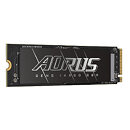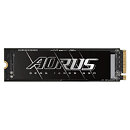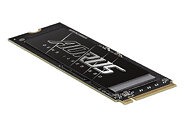- Joined
- Oct 9, 2007
- Messages
- 47,670 (7.43/day)
- Location
- Dublin, Ireland
| System Name | RBMK-1000 |
|---|---|
| Processor | AMD Ryzen 7 5700G |
| Motherboard | Gigabyte B550 AORUS Elite V2 |
| Cooling | DeepCool Gammax L240 V2 |
| Memory | 2x 16GB DDR4-3200 |
| Video Card(s) | Galax RTX 4070 Ti EX |
| Storage | Samsung 990 1TB |
| Display(s) | BenQ 1440p 60 Hz 27-inch |
| Case | Corsair Carbide 100R |
| Audio Device(s) | ASUS SupremeFX S1220A |
| Power Supply | Cooler Master MWE Gold 650W |
| Mouse | ASUS ROG Strix Impact |
| Keyboard | Gamdias Hermes E2 |
| Software | Windows 11 Pro |
GIGABYTE today launched its flagship M.2 NVMe SSD, the AORUS Gen5 14000 series. The drive packs the winning combination of Phison PS5026-E26 Max14um controller, with Micron B58R 232-layer 3D TLC NAND flash memory, along with a fast LPDDR4 DRAM cache. The drive comes in 1 TB, 2 TB, and 4 TB capacity variants. The maximum speeds vary for the three.
The 2 TB model is the fastest of the three, with a sequential read speed of up to 14,500 MB/s, and sequential write speed of up to 12,700 MB/s. The 4 TB model is the second fastest, with up to 14,100 MB/s sequential reads, and up to 12,600 MB/s sequential writes. The 1 TB model is third, with up to 13,600 MB/s sequential reads, and up to 10,200 MB/s sequential writes. All three models come without a heatsink, with just a metal film label on top. GIGABYTE recommends pairing the drive with M.2 SSD cooling solutions included with your motherboard to minimize performance throttling. The company didn't announce pricing.




View at TechPowerUp Main Site
The 2 TB model is the fastest of the three, with a sequential read speed of up to 14,500 MB/s, and sequential write speed of up to 12,700 MB/s. The 4 TB model is the second fastest, with up to 14,100 MB/s sequential reads, and up to 12,600 MB/s sequential writes. The 1 TB model is third, with up to 13,600 MB/s sequential reads, and up to 10,200 MB/s sequential writes. All three models come without a heatsink, with just a metal film label on top. GIGABYTE recommends pairing the drive with M.2 SSD cooling solutions included with your motherboard to minimize performance throttling. The company didn't announce pricing.




View at TechPowerUp Main Site







